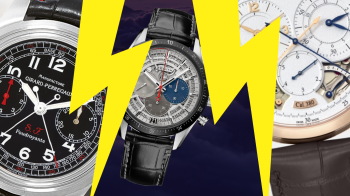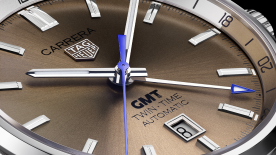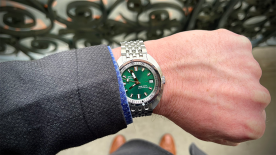It’s been a week filled with thunderbolts, my dear WorldTempus family. Those of you living in places rocked by scandal, political calamity, or surging virus caseloads, we’re right there with you — in spirit, if not physically (probably a good thing, in these spatially sensitive times). Our advice: stay home, keep the fridge stocked, and take a break from all that doom-scrolling with some lighter reading about mechanical watchmaking. (It says a lot about our current situation that I would refer to the following paragraphs about an unusual time indication as “light reading”.)
All these earth-shaking headlines falling around us put me in mind of a certain phrase. If you have had at any time an interest in the area of precise time indication — which is a totally separate thing from precise time measurement, although they are obviously linked — you will have encountered the term “lightning seconds”. The commonly held understanding of this term is that it refers to a hand (normally a chronograph hand) that completes one revolution every second.
Indeed, most examples of lightning seconds fits this definition precisely. However, when we refer closely to the foundation stone of horological education, the quadrilingual Illustrated Professional Dictionary of Horology by G. A. Berner, we find an expanded definition in play. Lightning seconds, listed under the rather quaint* term “jumping seconds”, refers to a hand which, “every second, completes one revolution round a special dial or jumps 4 or 5 times” (my italics).
If you’re going to follow this expanded definition to its logical conclusion, practically any mechanical watch with a seconds indication (that isn’t a dead-seconds indication) falls within these limits. This kind of epistemological redundancy hurts not only my brain, but my feelings too. Relying on good old common sense, let’s just agree that a lightning-seconds display refers to a hand that travels faster than the common one-rotation-per-minute seconds hand; a hand that indicates fractions of a second in clearly indicated jumps.
Lightning seconds are incorporated in chronographs from some of the most venerated houses of mechanical watchmaking, such as the Girard-Perregaux Scuderia Ferrari watches made around the turn of the millennium, the Zenith El Primero Striking 10th first presented in 2010, the TAG Heuer “Mikro” series of fast-beat chronographs, and the 2007 Jaeger-LeCoultre Duomètre à Chronographe, which used a lightning-seconds sub-counter to draw attention to its innovative new chronograph coupling system.
If you ask me, we don’t see this display often enough — just the animation of the hand racing around its dial is enough to quicken your pulse. In our current, thunderous existence, we can only look forward to a time when pure mechanical artistry is enough to make our hearts beat faster.
* I used the word “quaint” to refer to the term “jumping seconds”, but I really ought to use the word “confusing”. After all, a jumping-hours display moves one step per hour and a jumping-minutes display moves one step per minute. Why on earth does “jumping seconds” refer to a display that moves several steps per second? I hereby wish to express my extreme displeasure with this particular English entry in the Berner’s Dictionary. They should have just gone with a direct transliteration of the French term “seconde foudroyante”.










